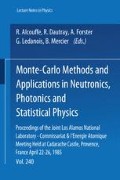Abstract
An algorithm has been implemented in CCUBE and ISIS to treat electron transport in materials using a Monte Carlo method in addition to the electron dynamics determined by the self-consistent electromagnetic, relativistic, particle-in-cell simulation codes that have been used extensively to model generation of electron beams and intense microwave production. Incorporation of a Monte Carlo method to model the transport of electrons in materials (conductors and dielectrics) in a particle-in-cell code represents a giant step toward realistic simulation of the physics of charged-particle beams. The basic Monte Carlo method used in the implementation includes both scattering of electrons by background atoms and energy degradation. Two methods were used to model the elastic scatterings. One is the theory due to Goudsmit and Saunderson and the other is given by Moliere, Hanson, and Bethe. In applying the former method, small angle scatterings were represented by Gaussian distributions with appropriate widths for the individual electrons and large angle scatterings were treated by the screened Coulomb distribution. In using the latter method, all scatterings were treated as small angle events; and, therefore, only the Gaussian term of the distribution was included. For energy degradation, it is assumed that the electrons are subjected to a slowing down force throughout their transport and that the force acts in a direction opposite to the electron's momentum. The energy loss is computed by using Bethe's formula, which treats the energy loss of incoming electrons in matter due to excitation and ionization of bound electrons in the stopping substance. Tests of the codes yielded electron transmission probability and its energy range relation, which agreed very well with empirical results. Furthermore, our results showed that space-charge effects could significantly affect the physics of electron transport. Further inclusion of photonic transport can lead to a new generation of numerical simulation tools.
Preview
Unable to display preview. Download preview PDF.
References
B. B. Godfrey, presented at the 8th Conference on Numerical Simulation of Plasmas, Monterey, California, 1978, PE-3.
G. Gisler, M. E. Jones, and C. M. Snell, “ISIS: A New Code for PIC Plasma Simulation,” Bull. Am. Phys. Soc., Vol. 29, 1208, 1984.
H. J. Bethe and J. Ashkin, Experimental Physics, Vol. 1, E. Segre (ed.), John Wiley and Company, New York (1953).
Conrad L. Longmire, “Effect of Multiple Scattering on the Compton Recoil Current,” MRC-R-178, Mission Research Corporation (Feb. 1978).
L. Katz and A. S. Penfold, Rev. Mod. Phys. 24, 28 (1952).
J. A. Halbleib and W. H. Vandervender, “CYLTRAN: A Cylindrical Geometry Multimaterial Electron/Photon Monte Carlo Transport Code,” Sandia Laboratories Report SAND 74-0030, March 1975.
C. Robert Emigh, “Thick Target Bremsstrahlung Theory,” Los Alamos Scientific Laboratory report LA-4097-MS, March 31, 1970.
Author information
Authors and Affiliations
Editor information
Rights and permissions
Copyright information
© 1985 Springer-Verlag
About this paper
Cite this paper
Kwan, T.J.T., Snell, C.M. (1985). Methods of Monte Carlo electron transport in particle-in-cell codes. In: Alcouffe, R., Dautray, R., Forster, A., Ledanois, G., Mercier, B. (eds) Monte-Carlo Methods and Applications in Neutronics, Photonics and Statistical Physics. Lecture Notes in Physics, vol 240. Springer, Berlin, Heidelberg. https://doi.org/10.1007/BFb0049043
Download citation
DOI: https://doi.org/10.1007/BFb0049043
Published:
Publisher Name: Springer, Berlin, Heidelberg
Print ISBN: 978-3-540-16070-0
Online ISBN: 978-3-540-39750-2
eBook Packages: Springer Book Archive

